Stream流简单使用
创建流
1 2 3 4 5 6 7 8 9 10 11 12 13 14 15 16 17 18 19 20 21 22 23 24 25 26 27 28 29 30 | /** * 创建流 */ @Test public void testOne() { List<Author> authorList = new ArrayList<>(); authorList.add(Author.builder().id(1).name("小白").address("浦东大道").build()); authorList.add(Author.builder().id(2).name("小红").address("星光大道").build()); //集合创建流 Stream<Author> stream = authorList.stream(); log.info("stream:{}", stream); Integer[] arr = {1, 2, 3, 4, 5, 6}; //数组创建流 Stream<Integer> integerStream = Arrays.stream(arr); log.info("integerStream:{}", integerStream); //数组创建流 Stream<Integer> integerStream1 = Stream.of(arr); log.info("integerStream1:{}", integerStream1); Map<String, Integer> map = new HashMap<>(16); map.put("1", 123); map.put("2", 234); map.put("3", 345); map.put("4", 456); Set<Map.Entry<String, Integer>> entrySet = map.entrySet(); //map集合创建流 Stream<Map.Entry<String, Integer>> entryStream = entrySet.stream(); log.info("entryStream:{}", entryStream); } |
filter过滤使用
1 2 3 4 5 6 7 8 9 10 11 12 13 14 15 16 17 18 19 | List<Author> authorList = new ArrayList<>(); authorList.add(Author.builder().id(1).name("小白").address("浦东大道").build()); authorList.add(Author.builder().id(2).name("小红").address("星光大道").build()); authorList.add(Author.builder().id(3).name("小绿").address("太古里").build()); authorList.add(Author.builder().id(4).name("小得子").address("三里屯").build()); //集合创建流 Stream<Author> stream = authorList.stream(); //打印id>2的且姓名长度等于3的 stream.filter(new Predicate<Author>() { @Override public boolean test(Author author) { Integer id = author.getId(); int length = author.getName().length(); if (id>2&&length==3){ return true; } return false; } }); |
转化为lamda表达式
List<Author> authorList = new ArrayList<>();
authorList.add(Author.builder().id(1).name("小白").address("浦东大道").build());
authorList.add(Author.builder().id(2).name("小红").address("星光大道").build());
authorList.add(Author.builder().id(3).name("小绿").address("太古里").build());
authorList.add(Author.builder().id(4).name("小得子").address("三里屯").build());
//集合创建流
Stream<Author> stream = authorList.stream();
//打印id>2的且姓名长度等于3的
stream.filter(author -> {
Integer id = author.getId();
int length = author.getName().length();
if (id>2&&length==3){
return true;
}
return false;
}).forEach(new Consumer<Author>() {
@Override
public void accept(Author author) {
log.info(author.toString());
}
});
继续简化
1 2 3 4 5 6 7 8 9 10 11 12 13 14 15 16 | List<Author> authorList = new ArrayList<>(); authorList.add(Author.builder().id(1).name("小白").address("浦东大道").build()); authorList.add(Author.builder().id(2).name("小红").address("星光大道").build()); authorList.add(Author.builder().id(3).name("小绿").address("太古里").build()); authorList.add(Author.builder().id(4).name("小得子").address("三里屯").build()); //集合创建流 Stream<Author> stream = authorList.stream(); //打印id>2的且姓名长度等于3的 stream.filter(author -> { Integer id = author.getId(); int length = author.getName().length(); if (id>2&&length==3){ return true; } return false; }).forEach(author -> log.info(author.toString())); |
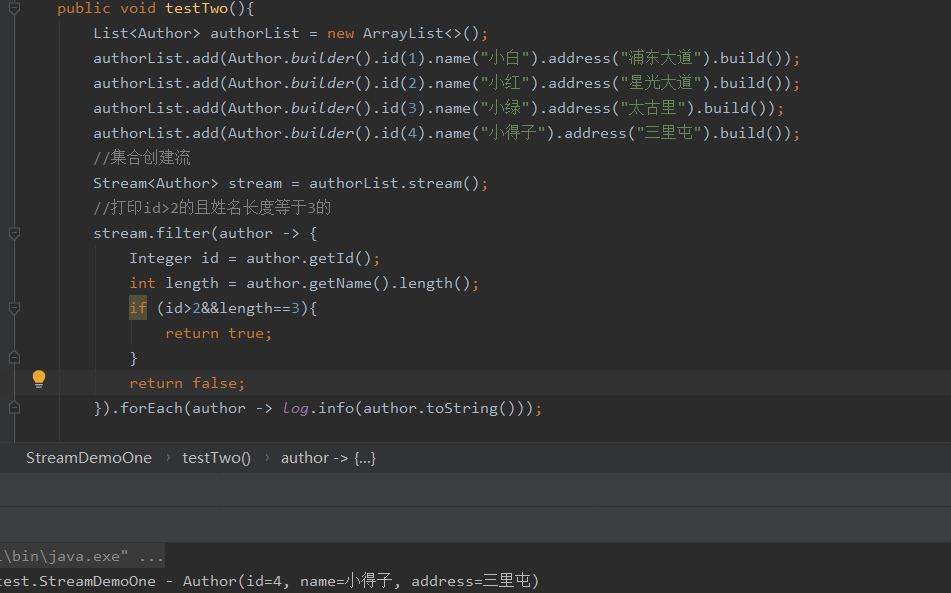
Stream中map使用(接受流中的元素,并且将其映射成新的元素)
1 2 3 4 5 6 7 8 9 10 11 12 13 14 15 16 17 18 19 20 21 22 | @Test public void mapTest(){ List<Author> authorList = new ArrayList<>(); authorList.add(Author.builder().id(1).name("小白").address("浦东大道").build()); authorList.add(Author.builder().id(2).name("小红").address("星光大道").build()); authorList.add(Author.builder().id(3).name("小绿").address("太古里").build()); authorList.add(Author.builder().id(4).name("小得子").address("三里屯").build()); //集合创建流 Stream<Author> stream = authorList.stream(); stream.map(new Function<Author, String>() { @Override public String apply(Author author) { return author.getName(); } }).forEach(new Consumer<String>() { @Override public void accept(String s) { log.info(s); } }); } |
转化为lamada表达式
1 2 3 4 5 6 7 8 9 10 11 | @Test public void mapTest(){ List<Author> authorList = new ArrayList<>(); authorList.add(Author.builder().id(1).name("小白").address("浦东大道").build()); authorList.add(Author.builder().id(2).name("小红").address("星光大道").build()); authorList.add(Author.builder().id(3).name("小绿").address("太古里").build()); authorList.add(Author.builder().id(4).name("小得子").address("三里屯").build()); //集合创建流 Stream<Author> stream = authorList.stream(); stream.map(author -> author.getName()).forEach(s -> log.info(s)); } |

使用distinct去重,其中需要特别注意的是distinct实现的去重功能依赖来自Object的equals方法来判断是否是相同的对象,所以需要重写equals方法
数据准备
1 2 3 4 5 6 7 8 9 10 11 12 13 14 15 16 17 18 19 20 21 22 23 24 25 26 27 28 29 30 31 32 33 34 35 36 37 38 39 40 41 42 43 | package com.java.test.bean;import lombok.Builder;import lombok.Data;import java.util.Objects;/** * @Description: * @Author: Yourheart * @Create: 2022/10/9 23:40 */@Data@Builderpublic class Author extends Object{ private Integer id; /** * 作家名称 */ private String name; /** * 作家的居住地址 */ private String address; @Override public boolean equals(Object o) { if (this == o) return true; if (o == null || getClass() != o.getClass()) return false; Author author = (Author) o; return Objects.equals(id, author.id) && Objects.equals(name, author.name) && Objects.equals(address, author.address); } @Override public int hashCode() { return Objects.hash(id, name, address); }} |
去重前
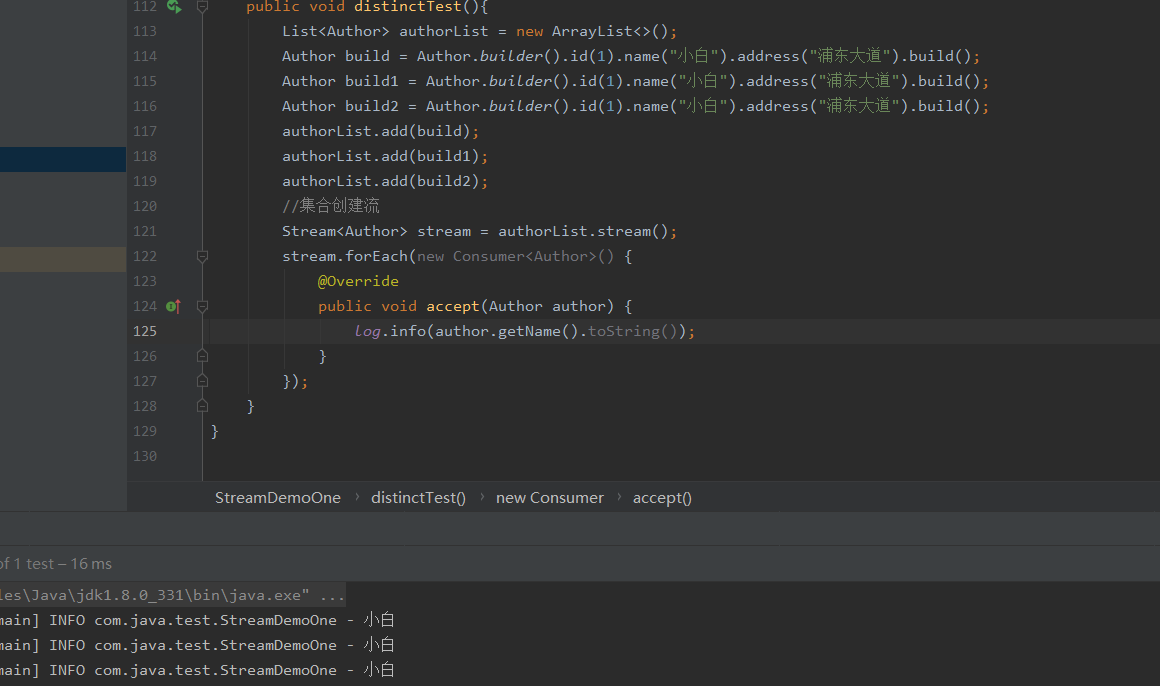
去重后
1 2 3 4 5 6 7 8 9 10 11 12 13 14 15 16 17 18 | @Test public void distinctTest(){ List<Author> authorList = new ArrayList<>(); Author build = Author.builder().id(1).name("小白").address("浦东大道").build(); Author build1 = Author.builder().id(1).name("小白").address("浦东大道").build(); Author build2 = Author.builder().id(1).name("小白").address("浦东大道").build(); authorList.add(build); authorList.add(build1); authorList.add(build2); //集合创建流 Stream<Author> stream = authorList.stream(); stream.distinct().forEach(new Consumer<Author>() { @Override public void accept(Author author) { log.info(author.getName().toString()); } }); } |
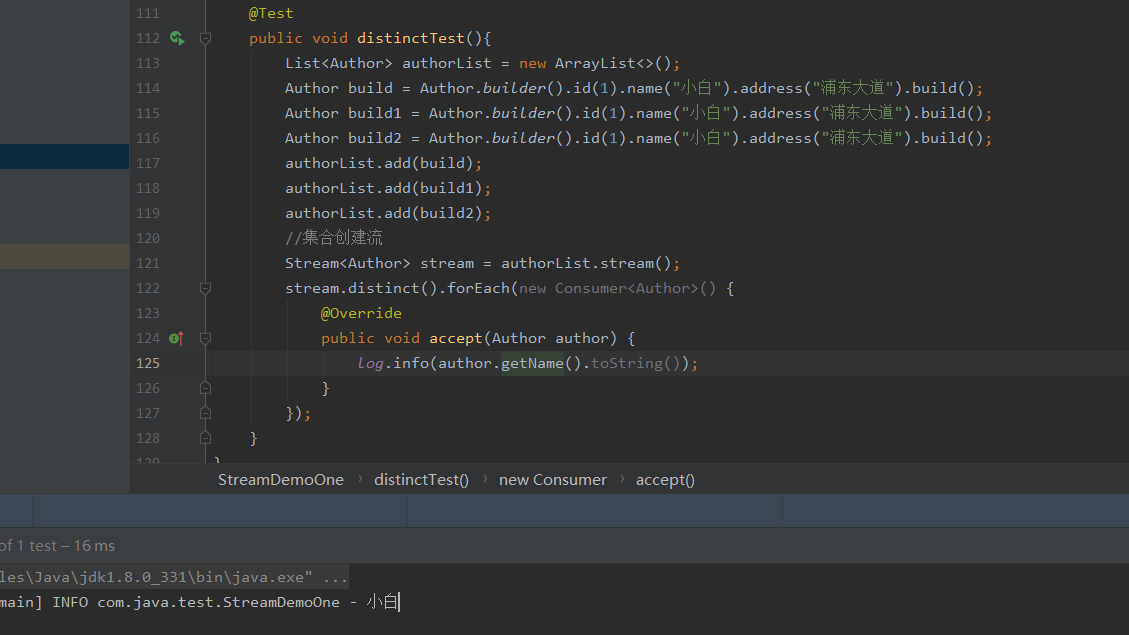
flatMap使用
去重每个作家中,重复的书籍
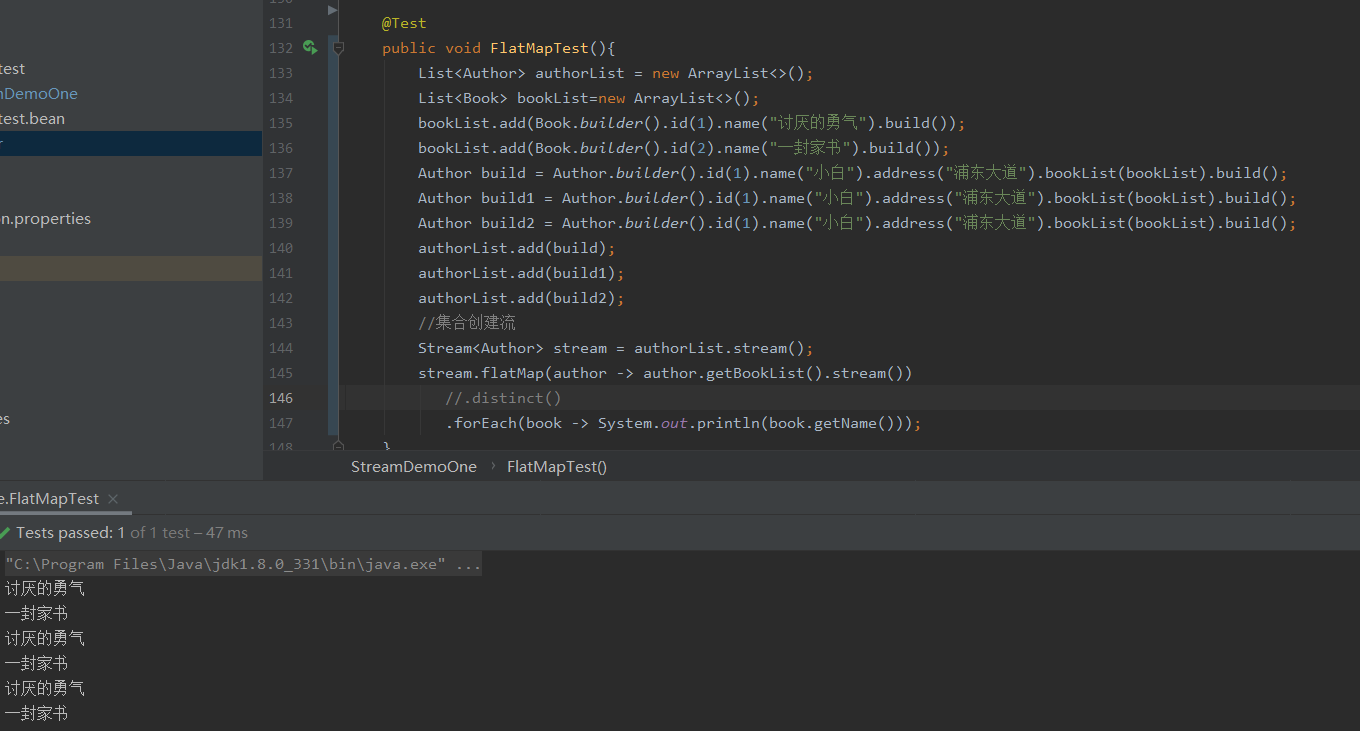
去重后

代码部分
1 2 3 4 5 6 7 8 9 10 11 12 13 14 15 16 17 18 | @Test public void FlatMapTest(){ List<Author> authorList = new ArrayList<>(); List<Book> bookList=new ArrayList<>(); bookList.add(Book.builder().id(1).name("讨厌的勇气").build()); bookList.add(Book.builder().id(2).name("一封家书").build()); Author build = Author.builder().id(1).name("小白").address("浦东大道").bookList(bookList).build(); Author build1 = Author.builder().id(1).name("小白").address("浦东大道").bookList(bookList).build(); Author build2 = Author.builder().id(1).name("小白").address("浦东大道").bookList(bookList).build(); authorList.add(build); authorList.add(build1); authorList.add(build2); //集合创建流 Stream<Author> stream = authorList.stream(); stream.flatMap(author -> author.getBookList().stream()) .distinct() .forEach(book -> System.out.println(book.getName())); } |
两个实体类
1 2 3 4 5 6 7 8 9 10 11 12 13 14 15 16 17 18 19 20 21 | package com.java.test.bean;import lombok.Builder;import lombok.Data;/** * @Description: * @Author: Yourheart * @Create: 2022/10/10 7:49 */@Data@Builderpublic class Book { private Integer id; /** * 书籍名称 */ private String name;} |
1 2 3 4 5 6 7 8 9 10 11 12 13 14 15 16 17 18 19 20 21 22 23 24 25 26 27 28 29 30 31 32 33 34 35 36 37 38 39 40 41 42 43 44 45 46 47 48 | package com.java.test.bean;import lombok.Builder;import lombok.Data;import java.util.List;import java.util.Objects;/** * @Description: * @Author: Yourheart * @Create: 2022/10/9 23:40 */@Data@Builderpublic class Author extends Object{ private Integer id; /** * 作家名称 */ private String name; /** * 作家的居住地址 */ private String address; private List<Book> bookList; @Override public boolean equals(Object o) { if (this == o) return true; if (o == null || getClass() != o.getClass()) return false; Author author = (Author) o; return Objects.equals(id, author.id) && Objects.equals(name, author.name) && Objects.equals(address, author.address) && Objects.equals(bookList, author.bookList); } @Override public int hashCode() { return Objects.hash(id, name, address, bookList); }} |
Foreach使用
1 2 3 4 5 6 7 8 9 10 11 12 13 14 15 16 17 | @Test public void foreachTest(){ List<Author> authorList = new ArrayList<>(); Author build = Author.builder().id(1).name("小兔子").address("浦东大道001").build(); Author build1 = Author.builder().id(2).name("小六子").address("浦东大道002").build(); Author build2 = Author.builder().id(3).name("小白").address("浦东大道003").build(); authorList.add(build); authorList.add(build1); authorList.add(build2); authorList.stream().forEach(new Consumer<Author>() { @Override public void accept(Author author) { System.out.println(author.toString()); } }); } |
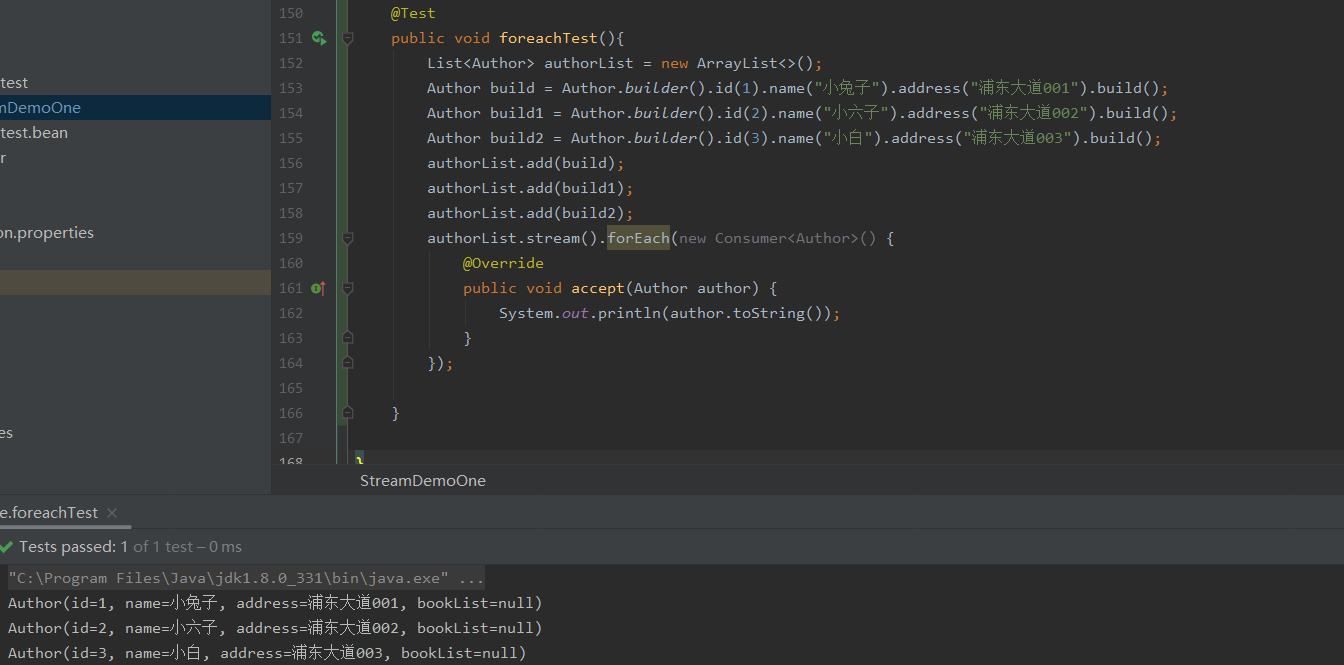
这里插入说点内容
stream收集器
含义就是将流转化为我们想要的集合类型,就是将最终的数据收集成List、Set、Map
转化为set集合
1 2 3 4 5 6 7 8 9 10 11 12 13 14 15 16 | @Test public void collectTest(){ List<Author> authorList = new ArrayList<>(); Author build = Author.builder().id(1).name("小兔子").address("浦东大道001").build(); Author build1 = Author.builder().id(2).name("小六子").address("浦东大道002").build(); Author build2 = Author.builder().id(3).name("小白").address("浦东大道003").build(); Author build3= Author.builder().id(3).name("小白").address("浦东大道003").build(); authorList.add(build); authorList.add(build1); authorList.add(build2); authorList.add(build3); Set<Author> collect = authorList.stream().collect(Collectors.toSet()); for (Author author : collect) { log.info("author:{}",author); } } |
同时这里还实现了去重功能

1 2 3 4 | 将流转化为list集合Collectors.toList()将流转化为set集合Collectors.toSet() |
将实体类以key-value形式放置map集合中
1 2 3 4 5 6 7 8 9 10 11 12 | @Test public void collectTest(){ Author build = Author.builder().id(1).name("小兔子").address("浦东大道001").build(); Author build1 = Author.builder().id(2).name("小六子").address("浦东大道002").build(); Author build2 = Author.builder().id(3).name("小白").address("浦东大道003").build(); Author build3= Author.builder().id(4).name("小红帽").address("浦东大道004").build(); Map<Integer, Author> collect = Stream.of(build, build1, build2, build3).collect(Collectors.toMap(Author::getId, Function.identity())); Set<Map.Entry<Integer, Author>> entries = collect.entrySet(); entries.forEach(a->{ log.info(a.toString()); }); } |
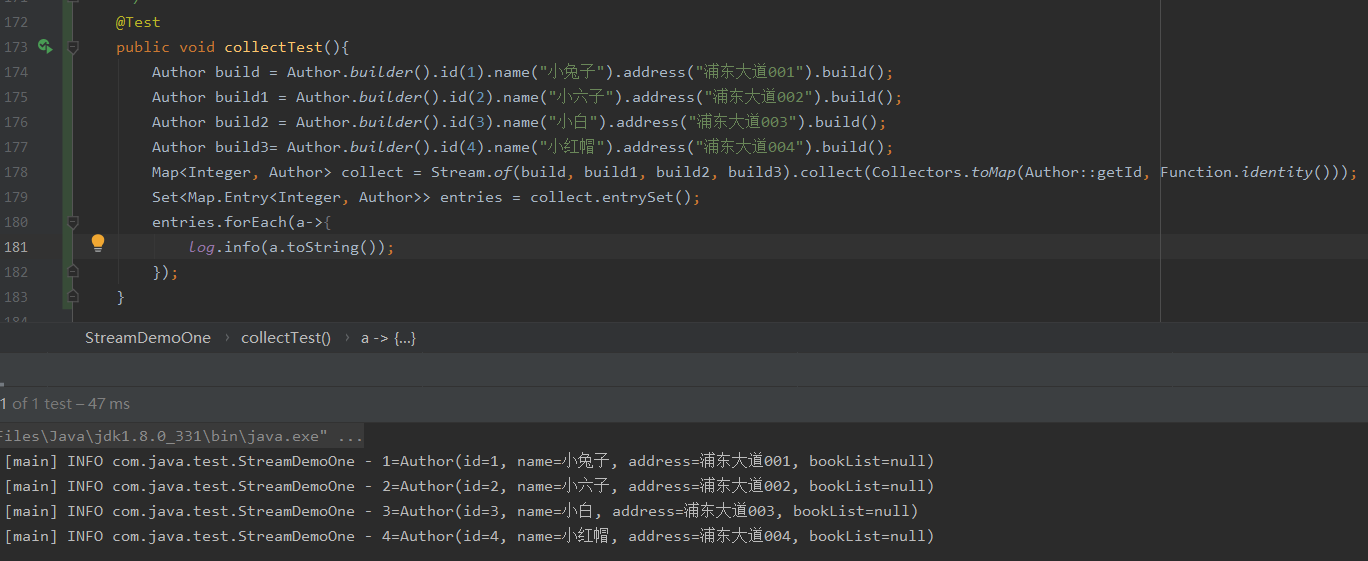
这里分别使用串行收集和并行收集打印耗时
1 2 3 4 5 6 7 8 9 10 11 12 13 14 15 16 17 18 19 20 21 22 23 24 | public void collectTest(){ Author build = Author.builder().id(1).name("小兔子").address("浦东大道001").build(); Author build1 = Author.builder().id(21).name("小六子").address("浦东大道002").build(); Author build2 = Author.builder().id(31).name("小白").address("浦东大道003").build(); Author build3= Author.builder().id(41).name("小红帽").address("浦东大道004").build(); Author build5 = Author.builder().id(11).name("小兔子").address("浦东大道001").build(); Author build6 = Author.builder().id(201).name("小六子").address("浦东大道002").build(); Author build7 = Author.builder().id(302).name("小白").address("浦东大道003").build(); Author build8= Author.builder().id(403).name("小红帽").address("浦东大道004").build(); Author build9= Author.builder().id(12).name("小兔子").address("浦东大道001").build(); Author build10 = Author.builder().id(22).name("小六子").address("浦东大道002").build(); Author build11= Author.builder().id(23).name("小白").address("浦东大道003").build(); Author build12= Author.builder().id(24).name("小红帽").address("浦东大道004").build(); long nanoTime = System.nanoTime(); //串行收集 Map<Integer, Author> collect = Stream.of(build, build1, build2, build3,build5,build6,build7,build8,build9,build10,build11,build12).collect(Collectors.toMap(Author::getId, Function.identity())); long nanoTime1 = System.nanoTime(); log.info("串行收集耗时:{} ns",nanoTime1-nanoTime); long nanoTime2 = System.nanoTime(); //并行收集 Map<Integer, Author> collect1 = Stream.of(build, build1, build2, build3,build5,build6,build7,build8,build9,build10,build11,build12).collect(Collectors.toMap(Author::getId, Function.identity())); long nanoTime3 = System.nanoTime(); log.info("并行收集耗时:{} ns",nanoTime3-nanoTime2); } |
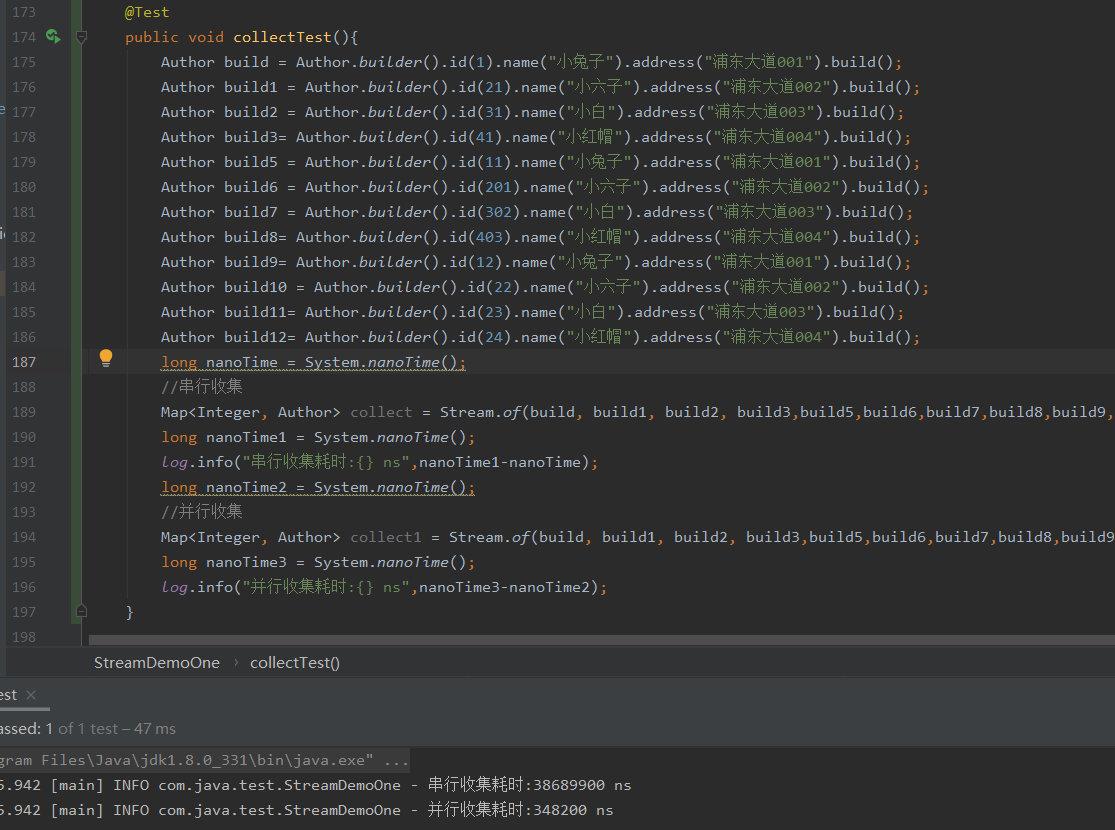
但是需要注意的是并行收集顺序会乱,同时数据如果存在重复的会报错,这点需要注意
前面是转化为id->Author形式
下面转化为id->name的形式
1 2 3 4 5 6 7 8 9 10 11 12 13 14 15 16 17 18 19 20 | @Test public void collectTest(){ Author build = Author.builder().id(1).name("小兔子").address("浦东大道001").build(); Author build1 = Author.builder().id(21).name("小六子").address("浦东大道002").build(); Author build2 = Author.builder().id(31).name("小白").address("浦东大道003").build(); Author build3= Author.builder().id(41).name("小红帽").address("浦东大道004").build(); Author build5 = Author.builder().id(11).name("小兔子").address("浦东大道001").build(); Author build6 = Author.builder().id(201).name("小六子").address("浦东大道002").build(); Author build7 = Author.builder().id(302).name("小白").address("浦东大道003").build(); Author build8= Author.builder().id(403).name("小红帽").address("浦东大道004").build(); Author build9= Author.builder().id(12).name("小兔子").address("浦东大道001").build(); Author build10 = Author.builder().id(22).name("小六子").address("浦东大道002").build(); Author build11= Author.builder().id(23).name("小白").address("浦东大道003").build(); Author build12= Author.builder().id(24).name("小红帽").address("浦东大道004").build(); Map<Integer, String> collect = Stream.of(build, build1, build2, build3, build5, build6, build7, build8, build9, build10, build11, build12) .collect(Collectors.toMap(Author::getId, Author::getName)); collect.entrySet().forEach(a->{ log.info(a.toString()); }); } |

下面继续说收集器中的聚合归约
1 2 3 4 5 6 7 8 9 10 11 12 | @Test public void joinTest(){ Author build = Author.builder().id(1).name("小兔子").address("浦东大道001").build(); Author build1 = Author.builder().id(21).name("小六子").address("浦东大道002").build(); Author build2 = Author.builder().id(31).name("小白").address("浦东大道003").build(); Author build3= Author.builder().id(41).name("小红帽").address("浦东大道004").build(); Author build5 = Author.builder().id(11).name("小兔子").address("浦东大道005").build(); String collect = Stream.of(build, build1, build2, build3, build5) .map(Author::getName) .collect(Collectors.joining("^_^")); log.info(collect.toString()); } |
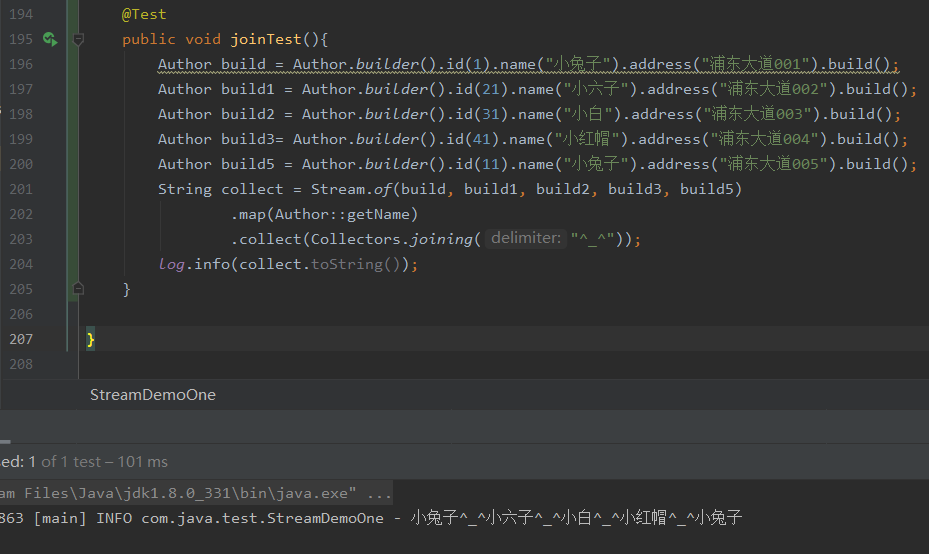
count使用
1 2 3 4 5 6 7 8 9 10 11 12 | @Test public void countTest(){ Author build = Author.builder().id(1).name("小兔子").address("浦东大道001").build(); Author build1 = Author.builder().id(21).name("小六子").address("浦东大道002").build(); Author build2 = Author.builder().id(31).name("小白").address("浦东大道003").build(); Author build3= Author.builder().id(41).name("小红帽").address("浦东大道004").build(); Author build5 = Author.builder().id(11).name("小兔子").address("浦东大道005").build(); Author build6 = Author.builder().id(12).name("小兔子3").address("浦东大道006").build(); List<Author> collect = Stream.of(build, build1, build2, build3, build5, build6).collect(Collectors.toList()); long count = collect.stream().count(); log.info("打印数量:{}",count); } |
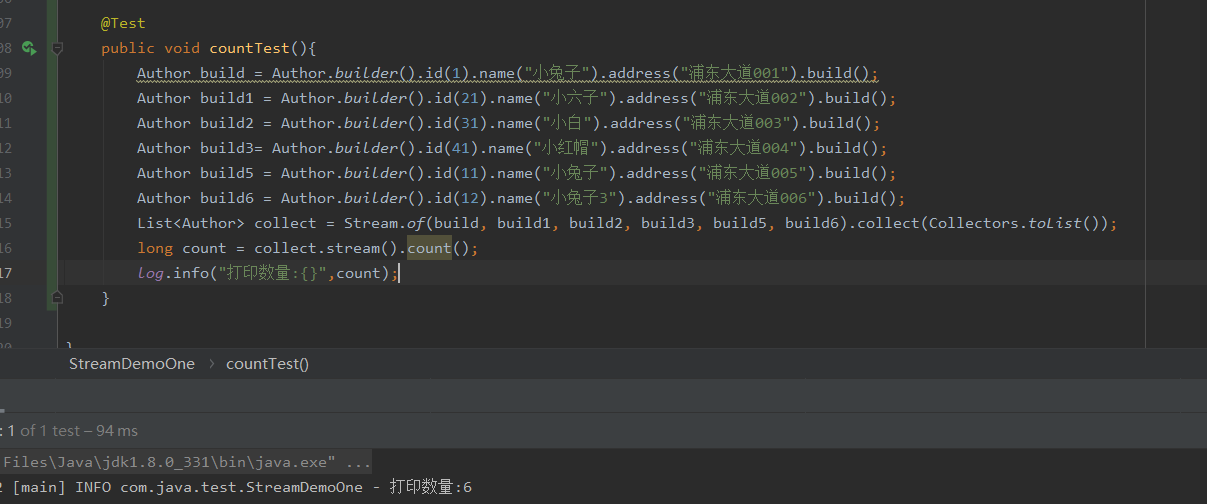
使用min和max获取最小值和最大值
1 2 3 4 5 6 7 8 9 10 11 12 13 14 15 16 | @Test public void minTest(){ Author build = Author.builder().id(1).name("小兔子").address("浦东大道001").build(); Author build1 = Author.builder().id(21).name("小六子").address("浦东大道002").build(); Author build2 = Author.builder().id(31).name("小白").address("浦东大道003").build(); Author build3= Author.builder().id(41).name("小红帽").address("浦东大道004").build(); Author build5 = Author.builder().id(11).name("小兔子").address("浦东大道005").build(); Author build6 = Author.builder().id(12).name("小兔子3").address("浦东大道006").build(); List<Author> collect = Stream.of(build, build1, build2, build3, build5, build6).collect(Collectors.toList()); Optional<Integer> min = collect.stream().map(author -> author.getId()) .min((a, b) -> a - b); log.info("min:{}",min.get()); Optional<Integer> max = collect.stream().map(author -> author.getId()) .max((a, b) -> a - b); log.info("max:{}",max.get()); } |
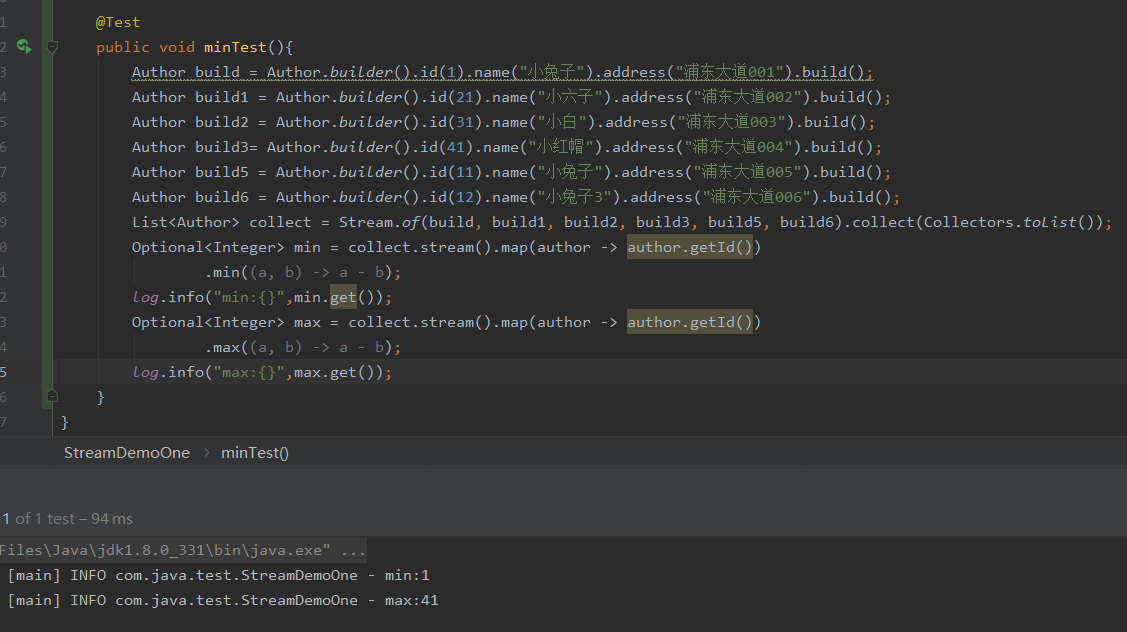
allmatchs使用,匹配满足的条件的数据,返回值为boolean
1 2 3 4 5 6 7 8 9 10 11 12 13 14 15 16 17 | @Test public void anyMatchTest(){ Author build = Author.builder().id(1).name("小兔子").address("浦东大道001").build(); Author build1 = Author.builder().id(21).name("小六子").address("浦东大道002").build(); Author build2 = Author.builder().id(31).name("小白").address("浦东大道003").build(); Author build3= Author.builder().id(41).name("小红帽").address("浦东大道004").build(); Author build5 = Author.builder().id(11).name("小兔子").address("浦东大道005").build(); Author build6 = Author.builder().id(12).name("小兔子3").address("浦东大道006").build(); List<Author> collect = Stream.of(build, build1, build2, build3, build5, build6).collect(Collectors.toList()); boolean anyMatch = collect.stream().anyMatch(new Predicate<Author>() { @Override public boolean test(Author author) { return author.getId() > 40; } }); log.info("anyMatch:{}",anyMatch); } |
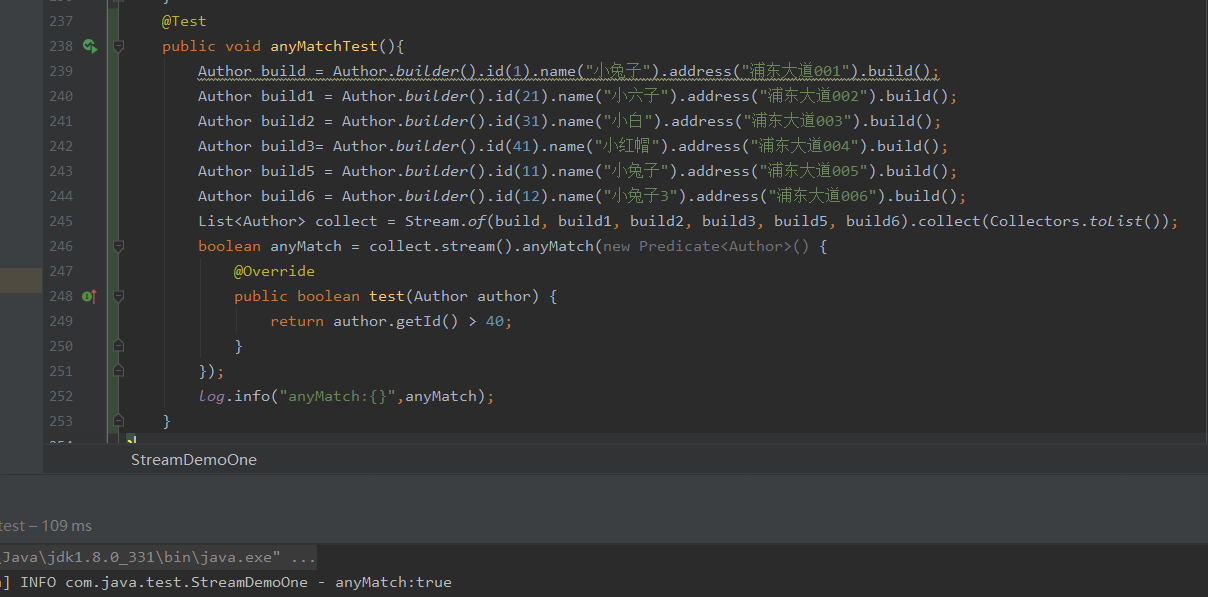
allmatch使用,都满足条件才会返回true
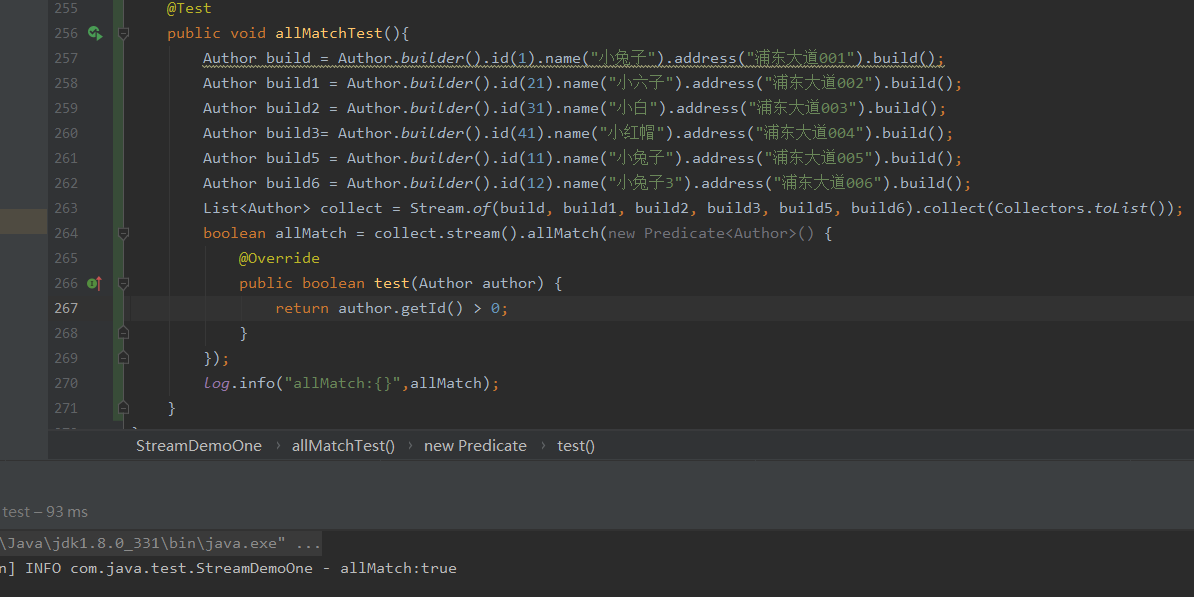
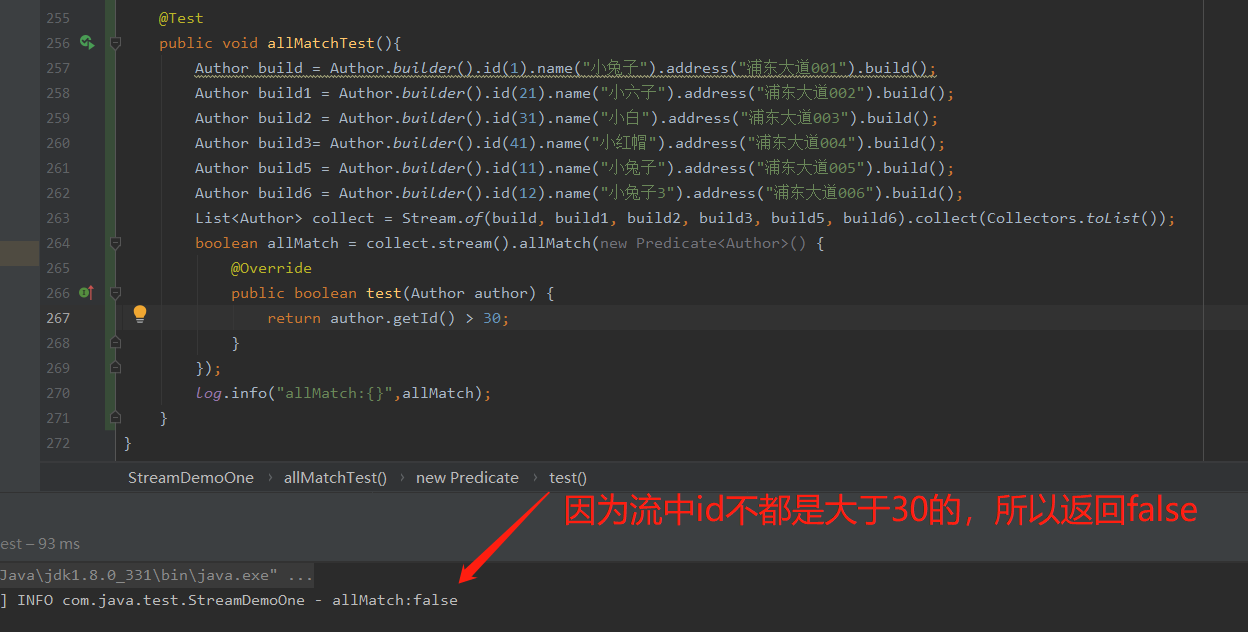
1 2 3 4 5 6 7 8 9 10 11 12 13 14 15 16 17 | @Test public void allMatchTest(){ Author build = Author.builder().id(1).name("小兔子").address("浦东大道001").build(); Author build1 = Author.builder().id(21).name("小六子").address("浦东大道002").build(); Author build2 = Author.builder().id(31).name("小白").address("浦东大道003").build(); Author build3= Author.builder().id(41).name("小红帽").address("浦东大道004").build(); Author build5 = Author.builder().id(11).name("小兔子").address("浦东大道005").build(); Author build6 = Author.builder().id(12).name("小兔子3").address("浦东大道006").build(); List<Author> collect = Stream.of(build, build1, build2, build3, build5, build6).collect(Collectors.toList()); boolean allMatch = collect.stream().allMatch(new Predicate<Author>() { @Override public boolean test(Author author) { return author.getId() > 30; } }); log.info("allMatch:{}",allMatch); } |
noneMatch表示都不匹配才会返回true,只要有一个返回就是false
1 2 3 4 5 6 7 8 9 10 11 12 13 14 15 16 17 | @Test public void noneMatchTest(){ Author build = Author.builder().id(1).name("小兔子").address("浦东大道001").build(); Author build1 = Author.builder().id(21).name("小六子").address("浦东大道002").build(); Author build2 = Author.builder().id(31).name("小白").address("浦东大道003").build(); Author build3= Author.builder().id(41).name("小红帽").address("浦东大道004").build(); Author build5 = Author.builder().id(11).name("小兔子").address("浦东大道005").build(); Author build6 = Author.builder().id(12).name("小兔子3").address("浦东大道006").build(); List<Author> collect = Stream.of(build, build1, build2, build3, build5, build6).collect(Collectors.toList()); boolean noneMatch = collect.stream().noneMatch(new Predicate<Author>() { @Override public boolean test(Author author) { return author.getName().contains("小兔"); } }); log.info("noneMatch:{}",noneMatch); } |

1 2 3 4 5 6 7 8 9 10 11 12 13 14 15 16 17 | @Test public void noneMatchTest(){ Author build = Author.builder().id(1).name("小兔子").address("浦东大道001").build(); Author build1 = Author.builder().id(21).name("小六子").address("浦东大道002").build(); Author build2 = Author.builder().id(31).name("小白").address("浦东大道003").build(); Author build3= Author.builder().id(41).name("小红帽").address("浦东大道004").build(); Author build5 = Author.builder().id(11).name("小兔子").address("浦东大道005").build(); Author build6 = Author.builder().id(12).name("小兔子3").address("浦东大道006").build(); List<Author> collect = Stream.of(build, build1, build2, build3, build5, build6).collect(Collectors.toList()); boolean noneMatch = collect.stream().noneMatch(new Predicate<Author>() { @Override public boolean test(Author author) { return author.getName().contains("萝卜"); } }); log.info("noneMatch:{}",noneMatch); } |
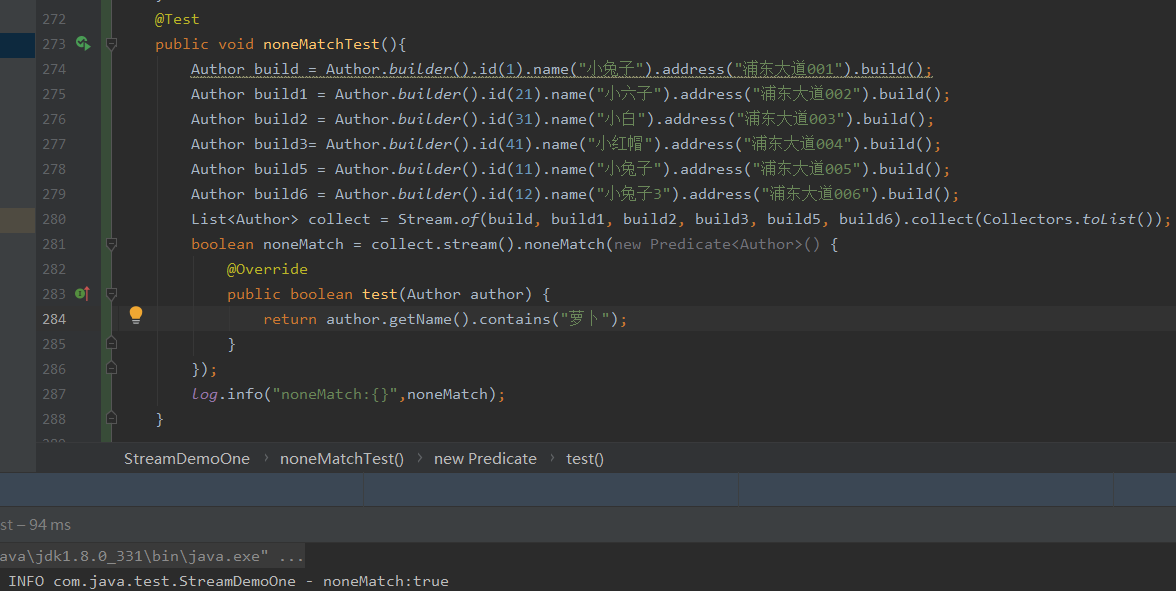
findFirst使用,查询满足条件的第一个元素
1 2 3 4 5 6 7 8 9 10 11 12 13 14 15 16 17 18 | @Test public void findAnyTest(){ Author build = Author.builder().id(1).name("小兔子").address("浦东大道001").build(); Author build1 = Author.builder().id(21).name("小六子").address("浦东大道002").build(); Author build2 = Author.builder().id(31).name("小白").address("浦东大道003").build(); Author build3= Author.builder().id(41).name("小红帽").address("浦东大道004").build(); Author build5 = Author.builder().id(11).name("小兔子").address("浦东大道005").build(); Author build6 = Author.builder().id(12).name("小兔子3").address("浦东大道006").build(); List<Author> collect = Stream.of(build, build1, build2, build3, build5, build6).collect(Collectors.toList()); Optional<Author> first = collect.stream().filter(new Predicate<Author>() { @Override public boolean test(Author author) { return author.getId() > 15; } }).findFirst(); Author author = first.get(); log.info("author:{}",author); } |

groupBy分组
1 2 3 4 5 6 7 8 9 10 11 12 13 14 15 16 17 18 19 20 21 22 | @Test public void groupByTest(){ Author build = Author.builder().id(1).name("小兔子").address("浦东大道001").build(); Author build1 = Author.builder().id(1).name("小六子").address("浦东大道002").build(); Author build2 = Author.builder().id(31).name("小白").address("浦东大道003").build(); Author build3= Author.builder().id(31).name("小红帽").address("浦东大道004").build(); Author build4= Author.builder().id(31).name("小红帽1").address("浦东大道004").build(); Author build5 = Author.builder().id(11).name("小兔子").address("浦东大道005").build(); Author build6 = Author.builder().id(12).name("小兔子3").address("浦东大道006").build(); List<Author> authorList=new ArrayList<>(); authorList.add(build); authorList.add(build1); authorList.add(build2); authorList.add(build3); authorList.add(build4); authorList.add(build5); authorList.add(build6); Map<Integer, List<Author>> collect = authorList.stream().collect(Collectors.groupingBy(Author::getId)); collect.entrySet().forEach(a->{ log.info(a.toString()); }); } |
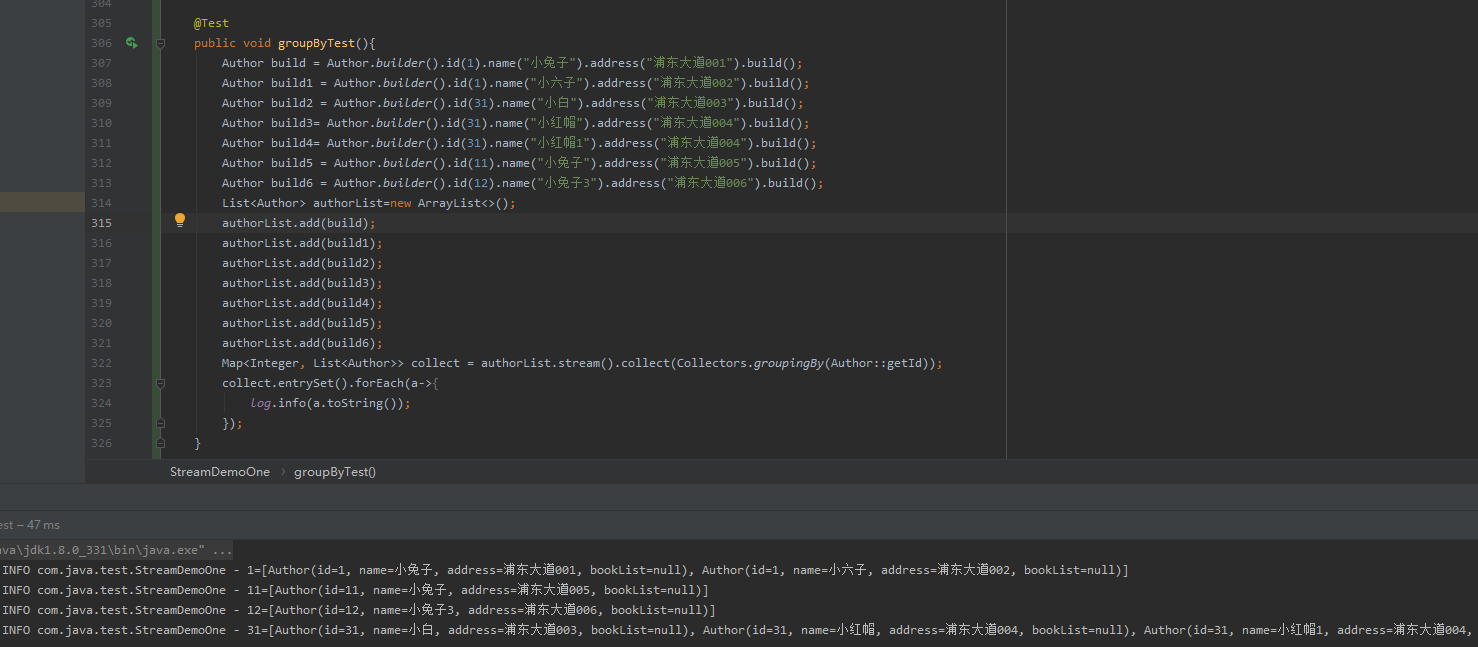
reduce使用求和
1 2 3 4 5 6 7 8 9 10 11 12 13 14 15 16 17 18 19 20 21 22 23 24 25 26 27 | @Test public void reduceTest(){ Author build = Author.builder().id(1).name("小兔子").address("浦东大道001").build(); Author build1 = Author.builder().id(1).name("小六子").address("浦东大道002").build(); Author build2 = Author.builder().id(31).name("小白").address("浦东大道003").build(); Author build3= Author.builder().id(31).name("小红帽").address("浦东大道004").build(); Author build4= Author.builder().id(31).name("小红帽1").address("浦东大道004").build(); Author build5 = Author.builder().id(11).name("小兔子").address("浦东大道005").build(); Author build6 = Author.builder().id(12).name("小兔子3").address("浦东大道006").build(); List<Author> authorList=new ArrayList<>(); authorList.add(build); authorList.add(build1); authorList.add(build2); authorList.add(build3); authorList.add(build4); authorList.add(build5); authorList.add(build6); Integer reduce = authorList.stream().map(author -> author.getId()) .reduce(0, new BinaryOperator<Integer>() { @Override public Integer apply(Integer result, Integer element) { return result + element; } }); log.info("reduce:{}",reduce); } |
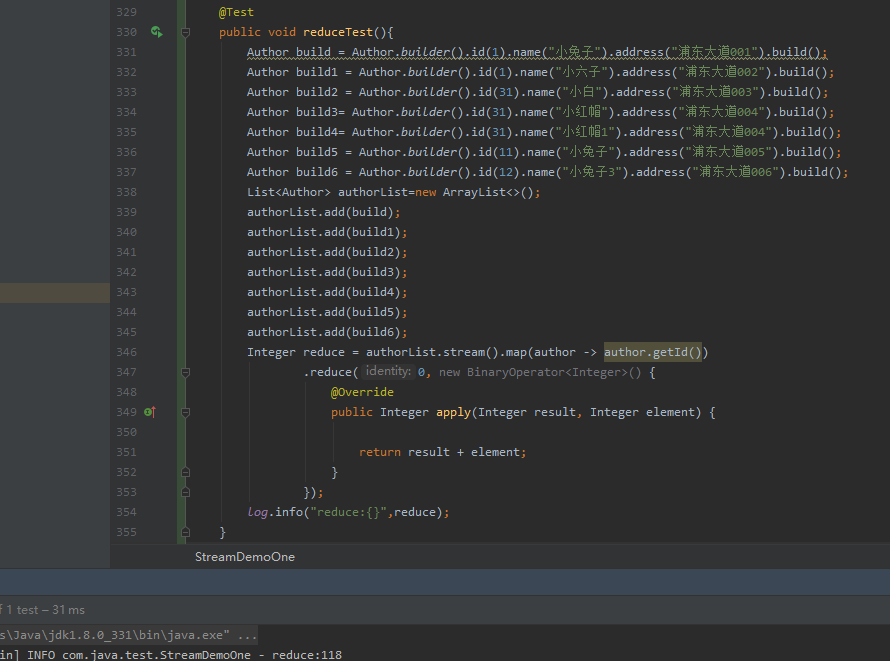
最后附上pom文件
1 2 3 4 5 6 7 8 9 10 11 12 13 14 15 16 17 18 19 20 21 22 23 24 25 26 27 28 29 30 31 32 33 34 35 36 37 38 39 40 41 42 43 44 45 46 47 48 49 50 51 52 53 54 55 | <?xml version="1.0" encoding="UTF-8"?><project xmlns="http://maven.apache.org/POM/4.0.0" xmlns:xsi="http://www.w3.org/2001/XMLSchema-instance" xsi:schemaLocation="http://maven.apache.org/POM/4.0.0 http://maven.apache.org/xsd/maven-4.0.0.xsd"> <modelVersion>4.0.0</modelVersion> <groupId>com.java</groupId> <artifactId>test-study</artifactId> <version>1.0-SNAPSHOT</version> <parent> <groupId>org.springframework.boot</groupId> <artifactId>spring-boot-starter-parent</artifactId> <version>2.2.1.RELEASE</version> <relativePath/> </parent> <dependencies> <dependency> <groupId>org.springframework.boot</groupId> <artifactId>spring-boot-starter</artifactId> </dependency> <dependency> <groupId>org.springframework.boot</groupId> <artifactId>spring-boot-starter-test</artifactId> <scope>test</scope> </dependency> <!--lombok依赖--> <dependency> <groupId>org.projectlombok</groupId> <artifactId>lombok</artifactId> <version>1.18.16</version> </dependency> <!--引入junit单元测试依赖--> <dependency> <groupId>junit</groupId> <artifactId>junit</artifactId> <version>4.12</version> </dependency> </dependencies> <build> <plugins> <plugin> <groupId>org.springframework.boot</groupId> <artifactId>spring-boot-maven-plugin</artifactId> </plugin> </plugins> <finalName>study</finalName> </build></project> |





【推荐】国内首个AI IDE,深度理解中文开发场景,立即下载体验Trae
【推荐】编程新体验,更懂你的AI,立即体验豆包MarsCode编程助手
【推荐】抖音旗下AI助手豆包,你的智能百科全书,全免费不限次数
【推荐】轻量又高性能的 SSH 工具 IShell:AI 加持,快人一步
· TypeScript + Deepseek 打造卜卦网站:技术与玄学的结合
· Manus的开源复刻OpenManus初探
· AI 智能体引爆开源社区「GitHub 热点速览」
· C#/.NET/.NET Core技术前沿周刊 | 第 29 期(2025年3.1-3.9)
· 从HTTP原因短语缺失研究HTTP/2和HTTP/3的设计差异